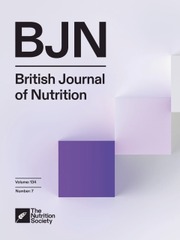Dear Editor,
We appreciate Dr. Joseph’s insightful comment on our paper reporting no association between red and processed meat intake and risk of type 2 diabetes in Japanese workers(Reference Nanri, Irie and Kochi1). Although this finding is inconsistent with the results of Western studies, it is supported by Japanese studies reporting no association between dietary patterns characterised by high meat and processed meat intake (referred to as the ‘Westernised dietary pattern,’ ‘high-fat dietary pattern’ and ‘animal food dietary pattern’) and type 2 diabetes(Reference Mizoue, Yamaji and Tabata2–Reference Nanri, Shimazu and Takachi4).
Of the factors that could influence the meat–diabetes association, the amount and type of red meat would be plausible explanations for our null finding. Specifically, red meat intake is lower in Japanese than in Westerners; the per capita annual intake of red meat (beef and pork combined) was 32·3 kg in Japan, compared with 67·9 kg in the USA and 43·5 kg in the UK(5). In addition, the type of red meat commonly consumed differs; beef accounted for 29 % of red meat in Japan, compared with 56 % in the USA and 40 % in the UK(5). Pork is rich in vitamin B1 and linoleic acid(6,Reference Vicente and Pereira7) , both of which have been associated with a reduced risk of type 2 diabetes(Reference Hu, Fang and Zhang8,Reference Ziegler, Reiners and Strom9) . Compared with pork, beef contains higher levels of Fe(6), which has been reported to be associated with an increased risk of type 2 diabetes(Reference Shahinfar, Jayedi and Shab-Bidar10).
Studies in Asia may provide additional insight. A recent region-specific meta-analysis by Li et al. found a significantly higher risk of type 2 diabetes associated with higher intake of unprocessed red meat in the Western Pacific region(Reference Li, Bishop and Imamura11). However, they also noted significant heterogeneity among the seven studies included in the meta-analysis, with only two (China and Singapore) showing a significant increase in diabetes risk associated with higher unprocessed red meat intake. Interestingly, three studies from Australia, where red meat consumption is relatively high (52·6 kg/capita/year)(5), reported no association(Reference Li, Bishop and Imamura11). These data suggest that the association between red meat and diabetes cannot be explained by intake alone. In this regard, we agree that intake of foods other than red meat (e.g. fish, beans, vegetables and fruits), dietary culture, including cooking methods, and lifestyle may have influenced the association. These issues should be addressed in future studies to clarify whether red meat and processed meat increase the risk of type 2 diabetes.
Acknowledgements
There are no conflicts of interest.
This research received no specific grant from any funding agency, commercial or not-for-profit sectors.



